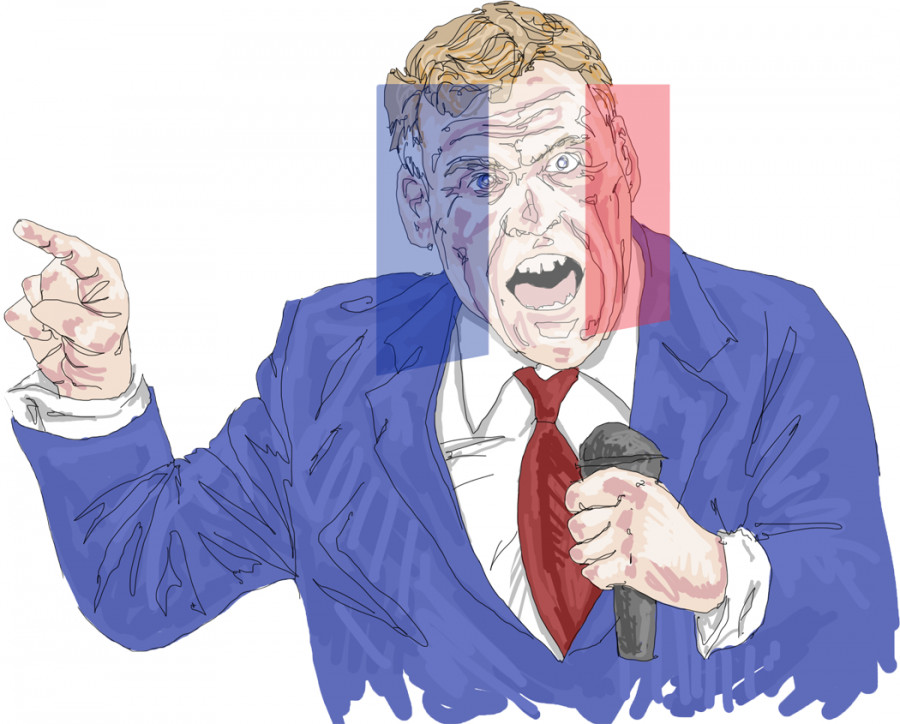Media Sensationalism in Response to Terrorism
Media’s Response to Terrorism Needs to Be Responsible
Less than a year since the attacks on the offices of the French satirical weekly Charlie Hebdo shocked the world, Paris was struck again by suicide bombers and gunmen. The reaction to the Nov. 13 attacks was no less intense. Western media was on high alert around the globe, and Quebec was no exception.
Read this story on the 2016 Media and Democracy microsite here.
The illustrious tabloid Le Journal de Montreal reliably acted as a shining example of how to turn a complex socio-political issue into a mobilization of xenophobic, nationalist feeling. The front page after the attacks was spectacular.
On a black background, a mugshot of the “mastermind” of the Paris attacks was superimposed. On the bottom, the words “Individu dangereux, surtout n’intervenez pas vous-meme,” were printed in black script, taken from a suspect alert by French police. Below in enormous type: “RECHERCHÉ MONDIALEMENT.”
A banner below advertised 17 pages on the attacks on the backdrop of the French flag. The impression was immediate and striking. “You are in danger!” the reader was told. The headline was effective in its communication of fear and urgency.
But in Quebec, one of the most populous provinces in so-called multicultural Canada, the greatest threat to the people may not be a Belgian kamikaze but the harm done to visible Muslim minorities after the xenophobic rhetoric such attacks provoke.
Concordia student Sophia Sahrane spoke out about the effects the attacks have had on her in a Facebook post.
“I am angry. Helpless and angry. Because tonight my cousin, one of the most important person in my life, [couldn’t] came out to my first poetry reading ever to support me. […] Because she didn’t feel SAFE taking the metro,” the School of Community and Public Affairs student wrote.
It’s not just Le Journal de Montreal that focuses on the sensational to the detriment of Muslims at home.
“Because it’s okay for people to post videos threatening to kill a certain group of people. Because she’s a hijabi and wears her scarf proudly […] but in weighting in whether or not to take the metro, she has to take into account the chances of someone pushing her to her death.”
The feelings of fear that pervade the lives of Muslims sadly aren’t unwarranted. When a mosque in Peterborough, Ontario lit on fire Nov. 14, it was considered backlash from the attacks in Paris.
“This evil can be overcome, as evil has been overcome in human history before. But fear is not the answer. Vengeful rage is not the answer,” Ontario Premier Kathleen Wynne said in Ontario’s Legislative Assembly following the arson.
It’s not just Le Journal de Montreal that focuses on the sensational to the detriment of Muslims at home.
On the main front page of La Presse the Monday following the attacks, an Associated Press photo of a French soldier under the Eiffel Tower was plastered above the fold. The photo was lined with black text-boxes. Overlaid on the photo in contrasting white was the headline “LA RIPOSTE,” or the retaliation.
Tuesday’s front page features another militaristic photo that features three police in full riot gear and gas masks. While the coverage wasn’t as overtly xenophobic as that of its tabloid counterpart, it nonetheless focused on the military-style response to a country in mourning.
Le Devoir was on the opposite end of the spectrum, presenting the calmest, least sensational photos. Though the front page features something similar to that of _La Presse_—a soldier under the Eiffel Tower—the effect couldn’t be more different.
Rather than taking up the entire page above the fold, the photo used by Le Devoir takes up less than a third of the above-fold space. The background behind the Eiffel Tower was lighter and shows a blue sky. Instead of seeing a soldier with a machine gun superimposed on the iconic French monument, the soldier on Le Devoir’s cover blends into the background.
The main headline was “Apres le choc, la riposte.” Like the photo, something which on a surface level seems similar creates an entirely different effect. The title isn’t in all caps, and acknowledges the tragedy before referring to the search for the perpetrators
Their coverage was especially striking in contrast to Le Journal de Montreal. While the latter chose the most visually shocking photos and type possible, the former refrained from overtly sensationalizing the issue, instead choosing a more subtle, rounded-out presentation of the facts.
There’s no way to prove that the correlation between sensationalist, islamophobic media coverage is a direct cause of hate crimes against muslims, but it’s hardly a stretch to infer one fuels the other.


_600_832_s.png)


_600_375_90_s_c1.jpg)
_600_375_90_s_c1.jpg)